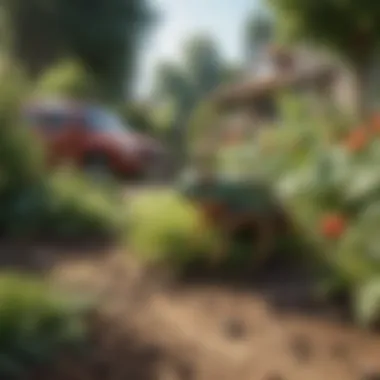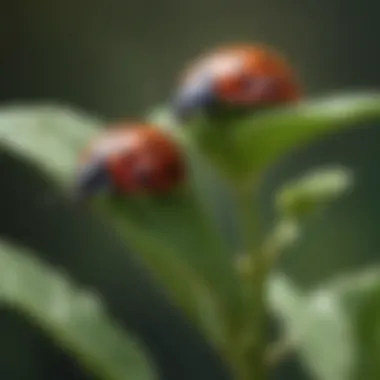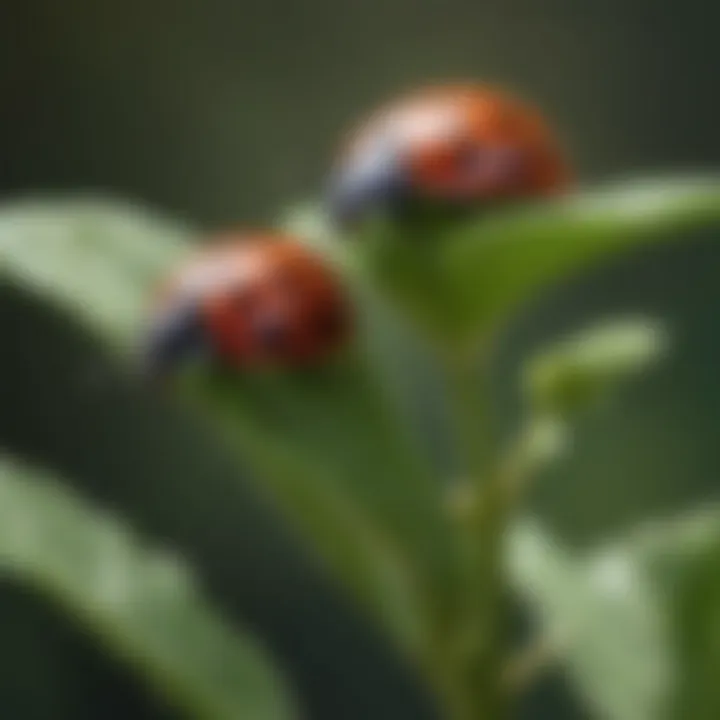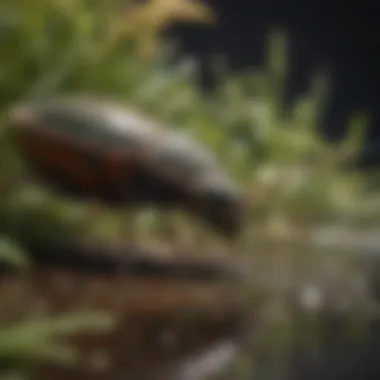Eco-Friendly Pest Control: Sustainable Strategies


Intro
Understanding how to control pests while being conscious of the environment is essential. This guide will delve into eco-friendly pest control methods, aiming to educate homeowners and gardening enthusiasts about environmentally sustainable practices. By focusing on integrated pest management and the role of beneficial insects, the goal is to promote methods that not only protect your home but also the ecosystem at large.
Understanding the Pest
Identification
To effectively manage pests, it is critical first to recognize them. Identification involves observing the physical characteristics of the pest. This includes size, color, and behavior. For example, identifying common household pests like ants, cockroaches, or termites can help determine the best control strategy. Utilize local resources or pest identification guides to ensure accuracy in your observations.
Life Cycle
Each pest has a life cycle that is integral to its management. Familiarizing yourself with the stages—egg, larva, pupa, and adult—helps in choosing the right timing for control measures. Many pests reproduce quickly, making it crucial to intervene at the right phase. For instance, targeting young larvae before they mature can reduce the pest population significantly. Attention to detail in this phase is vital for effective control.
Pest Prevention Strategies
Environment Modification
One significant way to control pests is through environment modification. This approach entails altering the surroundings to make them less inviting to pests. Common practices include:
- Eliminating standing water to prevent mosquito breeding.
- Sealing cracks and crevices in homes to block entryways for insects.
- Proper food storage to deter ants and other scavengers.
These changes not only deter pests but also contribute to an healthier living environment.
Physical Barriers
Physical barriers are another preventative strategy. These methods involve creating obstacles to keep pests at bay, offering a solution without chemicals. Some effective barriers include:
- Screens on windows and doors to prevent insects from entering.
- Row covers in gardens to protect seedlings from harmful insects.
- Traps and boards specifically designed to capture pests before they can spread.
Implementing these measures can significantly reduce pest encounters in your home.
Control Methods
Chemical Control
Although this guide emphasizes eco-friendly practices, chemical control is relevant. When necessary, opt for targeted, low-impact pesticides that minimize harm to beneficial organisms. Always read labels carefully, and follow application guidelines to limit exposure to the environment. Understanding that these should be the last resort will help you maintain a balanced ecosystem.
Biological Control
Biological control uses natural predators to manage pest populations. For instance, introducing ladybugs can help control aphid populations in gardens. This method promotes a balance in the ecosystem, allowing both plants and beneficial insects to thrive. Research local beneficial insects to find effective partners in pest control.
"Integrating multiple strategies for pest management can lead to long-term solutions, effectively balancing pest control with environmental health."
In summary, managing pests through an environmentally friendly approach is not just about eliminating the pest itself. It involves a comprehensive understanding of the pest, implementing prevention strategies, and selecting control methods that favor ecosystem integrity. By following these guidelines, homeowners can protect their properties while contributing positively to the surrounding environment.
Understanding Environment-First Pest Control
Understanding environment-first pest control is crucial for anyone looking to manage pests while minimizing harm to the ecosystem. This approach centers on using methods that respect natural processes and promote sustainability. The focus shifts from traditional chemical solutions to strategies that consider the long-term health of our surroundings and those who inhabit them. By prioritizing ecological balance, this guide aims to equip homeowners and gardening enthusiasts with knowledge and tools that support healthier environments.
Definition and Principles
Environment-first pest control refers to pest management strategies that prioritize ecological balance and minimize the impact on the environment. This concept is rooted in principles such as prevention, monitoring, and utilizing natural control methods. Essentially, the main goal is to reduce pest populations while maintaining a healthy ecosystem.
Some key elements include:
- Prevention: Implementing practices that deter pests before they become a problem, such as proper sanitation and crop rotation.
- Monitoring: Regularly checking for signs of pest activity to ensure that interventions are timely and effective.
- Natural Control: Using beneficial insects and other non-toxic methods to manage pest populations.
By adopting these principles, individuals can achieve effective pest control without resorting to harmful chemicals.
Historical Context of Pest Control


To fully appreciate the importance of environment-first pest control, it is essential to examine its historical background. For centuries, humans have waged war against pests, often relying on toxic chemicals and heavy-handed approaches that yielded immediate results but caused long-term damage. The Green Revolution of the mid-20th century, marked by the rise of synthetic pesticides like DDT, offers a stark example of this trend.
Initially, these chemicals were celebrated for their effectiveness, but over time, the consequences became painfully clear. Declining bee populations, pesticide resistance, and soil degradation highlighted the need for a more balanced approach.
Today, a growing awareness of environmental issues has led to a shift back towards natural methods. Homeowners and gardeners are increasingly recognizing the value of biodiversity and the role it plays in pest control. The historical lessons learned serve as a foundation for developing more sustainable practices that respect both the environment and human health.
The Importance of Eco-Friendly Practices
Eco-friendly practices play a critical role in pest control. These methods prioritize the use of natural interventions over synthetic chemicals, contributing to healthier ecosystems. By promoting sustainability, eco-friendly pest control aims to reduce the environmental footprint of pest management activities.
One of the core benefits of adopting these practices is the reduction of chemical pollutants in both residential and agricultural settings. Traditional pest control often relies heavily on synthetic pesticides. This can lead to soil and water contamination, adversely affecting local wildlife, plants, and ultimately, human populations.
Impact of Chemical Controls
Chemical controls, though effective in immediate pest elimination, often come with long-term consequences. The frequent application of products like glyphosate and neonicotinoids can result in pesticide resistance in pests. Over time, this makes these chemicals less effective, forcing users to rely on even harsher alternatives.
Additionally, the leaching of chemicals into water supplies can harm aquatic life and disrupt entire ecosystems. Such impacts lead to a cascading effect on biodiversity, with fewer beneficial organisms, like pollinators, surviving in heavily treated environments. The cumulative effects of chemical controls are substantial, highlighting the need for more environmentally conscious alternatives.
Health Implications for Humans and Pets
The health implications of chemical pest control are a significant concern for homeowners. Many synthetic chemicals are linked to health issues, including respiratory problems, skin irritations, and even more severe long-term conditions such as cancer. Households with pets, particularly, must be cautious, as these chemicals can be toxic to animals, leading to serious health problems or, in extreme cases, death.
By choosing eco-friendly practices, homeowners can mitigate these risks. The use of natural pest deterrents and non-toxic traps not only protects human beings but also safeguards pets from potential harm. This commitment to safety underscores the importance of transitioning to integrated pest management strategies that emphasize ecological balance.
Biodiversity Preservation
Biodiversity is essential for the stability and resilience of ecosystems. It ensures natural resources can regenerate and thrive. Eco-friendly pest control supports biodiversity preservation by reducing habitat destruction and chemical runoff. By fostering natural predators through thoughtful landscape management, pest populations can be naturally controlled.
The choice to use environment-first approaches creates a landscape that encourages healthy ecosystems. Planting diverse species not only deters pests but also attracts beneficial insects, like ladybugs and lacewings, which can help control detrimental pest species. The interconnectedness of plants, insects, and animals creates a balanced ecosystem, rather than a cycle of dependency on chemicals.
"Choosing eco-friendly pest control is not just about reducing chemicals; it's about fostering a healthier environment for all species, including ourselves."
In essence, the importance of eco-friendly practices in pest control is underscored by their benefits for human health, wildlife preservation, and ecological balance. By recognizing these elements, homeowners and gardeners can make informed decisions that lead to healthier living spaces.
Integrated Pest Management Strategies
Integrated Pest Management, commonly known as IPM, constitutes a holistic approach that prioritizes environmentally sound solutions to pest control. This method stands out for its multifaceted nature, allowing for a blend of various strategies tailored to specific pest challenges. By adopting IPM, homeowners and gardeners can achieve effective pest control while minimizing the detrimental effects on the ecosystem.
One fundamental tenet of IPM is its adaptive nature. It requires constant observation and assessment of pest populations as well as the conditions that invite these pests. Here are several crucial components of Integrated Pest Management Strategies:
- Cultural Practices: This involves changing how a garden or home area is managed to create unfavorable conditions for pests. Practices may include rotating crops, proper sanitation, and choosing pest-resistant plant varieties. By modifying cultural approaches, growers can significantly decrease the likelihood of pest infestations.
- Monitoring and Identification: Understanding which pests are present and in what numbers is vital for effective management. Monitoring tools, such as pest traps and visual inspections, provide insight into pest life cycles and reproductive rates. Correct identification of pests prevents unnecessary treatments that could be harmful to beneficial organisms.
- Mechanical and Physical Controls: This category includes physical barriers, traps, and other methods that do not involve chemicals. Examples include using row covers, handpicking pests, and employing traps designed for specific pests. These tactics can be especially effective in reducing pest populations without harming the surrounding environment.
- Biological Control Agents: Utilizing natural predators or parasites can help maintain pest populations at manageable levels. This strategy often involves introducing beneficial insects, such as ladybugs or predatory wasps, that can significantly reduce pest numbers naturally. Emphasizing biological controls aligns with the goal of creating a balanced ecosystem.
Implementing these IPM strategies results in reduced reliance on chemical pesticides, thus promoting a healthier environment. As a result, the overall health of plants improves, and the ecological balance is maintained.
"IPM is not about eradicating all pests; it is about managing them wisely and sustainably."
Natural Pest Deterrents
Natural pest deterrents are essential in maintaining a balanced and healthy ecosystem. They provide a sustainable alternative to chemical pesticides, which often harm not only pests but also beneficial insects, humans, and the environment. By using natural methods, homeowners are empowered to create a safer living environment while addressing pest issues effectively.
These deterrents can be categorized into various forms such as essential oils, homemade traps, and barriers, each serving a specific purpose in pest control. The primary benefits include reduced chemical exposure, enhanced biodiversity, and cost-effectiveness, which make them appealing for households looking for eco-friendly solutions.
Incorporating natural pest deterrents requires understanding their proper application and effectiveness. Certain essential oils can repel pests when diffused or applied to surfaces, while homemade traps can capture unwanted insects without causing harm to the environment. These methods are not only practical but also align with eco-conscious living.
Natural pest deterrents not only protect the environment, but they also promote a healthier home.
Essential Oils and Their Uses
Essential oils are concentrated plant extracts that possess strong properties, providing effective pest deterrence when used correctly. They can repel a variety of pests such as mosquitoes, ants, and fleas due to their strong scents and aromatic compounds.
Common oils like lavender, peppermint, and tea tree oil are particularly useful. These oils can be mixed with water or carrier oils for application. Homeowners can create a simple spray by combining a few drops of essential oil with water in a spray bottle. Mist around areas prone to pest activity, such as doorways and windows. This method can significantly reduce the presence of irritating pests without introducing harmful chemicals into your space.


It's important to note that while essential oils offer pest-repelling benefits, they should be used with caution, especially around pets and small children. Always dilute them properly and test on a small area before wider use.
Homemade Traps and Barriers
Homemade traps and barriers provide a practical and straightforward approach to managing pest issues without the use of commercial products. These DIY solutions can be made from common household items and are often less expensive than store-bought alternatives.
Some effective homemade traps include:
- Jar traps: Place sweet drink or fruit in a jar. Insects are attracted and get trapped inside.
- Soap and water traps: Mix water with dish soap in a bowl; the soap reduces surface tension, trapping flying insects that land on it.
Barriers can be created using simple materials as well. Here are some ideas:
- Diatomaceous earth: Sprinkle this natural powder around plants. It can deter crawling insects by physically damaging their exoskeletons.
- Row covers and mesh nets: These can protect valuable plants from both insect pests and larger animals.
By incorporating homemade traps and barriers into your pest management routine, you not only save money but also reduce the environmental impact associated with mass-produced pest control solutions.
Role of Beneficial Insects
Beneficial insects play a crucial role in environment-first pest control strategies. They contribute to natural pest management, reducing the need for chemical interventions. Utilizing beneficial insects, like ladybugs and lacewings, can create a more balanced ecosystem in gardens and agricultural fields. This method not only controls pest populations but also supports the health of plants and soil.
The presence of beneficial insects can lead to a natural reduction of harmful pests. Several species, such as parasitoids, consume or parasitize pests, effectively controlling their numbers. These insects can help maintain the ecological balance, creating a sustainable garden environment.
Identifying Beneficial Species
To effectively leverage beneficial insects, one must first identify which species provide the most advantages. Key beneficial insects include:
- Ladybugs: Known for their appetite for aphids and other harmful pests.
- Predatory mites: Effective against spider mites and other small pest species.
- Lacewings: Their larvae consume a wide variety of soft-bodied pests.
- Parasitic wasps: These target specific pest populations, laying eggs inside host pests.
Proper identification often requires both observation and a bit of research. For instance, knowing the life cycles of these insects and their appearance at different stages helps avoid confusion with pests. Online resources such as Wikipedia can provide helpful guides for identification.
Encouraging Biodiversity in Gardens
Creating a diverse garden can significantly enhance the presence of beneficial insects. There are several strategies to promote biodiversity:
- Plant Variety: Grow a mix of native plants, flowers, and herbs. This will attract a wider range of beneficial insects.
- Seasonal Planting: Introduce plants that bloom at different times during the year. This ensures a continuous food source for beneficial insects.
- Avoiding Pesticides: Reduce or eliminate pesticide use to protect beneficial insects and promote their populations. Notably, chemical pesticides can lead not only to the decline of harmful pests but also beneficial insects.
- Natural Habitats: Incorporate elements like logs, stones, or mulch. These can provide shelter for beneficial insects and help them thrive.
"Biodiversity is the foundation of a sustainable ecosystem."
By enhancing the biodiversity within the garden, house owners can create an inviting habitat that naturally supports beneficial insects. This approach decreases dependency on chemical pest control methods, aligning with the principles of sustainable gardening.
Case Studies: Successful Environment-First Pest Control
Case studies play a vital role in understanding the practical application of environment-first pest control strategies. These real-world examples shed light on how communities and individuals have adopted sustainable practices to manage pest issues while prioritizing ecosystem health. They demonstrate the effectiveness of non-chemical methods and highlight the broader benefits that these strategies bring to neighborhoods and urban spaces. For homeowners and gardening enthusiasts, these insights can offer inspiration and practical knowledge for similar undertakings.
Community Gardens
Community gardens serve as a strong example of successful environment-first pest control. These gardens rely on collective effort, creating a shared space for growing food and fostering community. Voluntary gardeners employ diverse methods to maintain healthy plants without heavy reliance on synthetic pesticides.
Several strategies emerge from community gardens:
- Crop Diversity: By planting a variety of crops, gardeners can disrupt pest life cycles and reduce infestations. Diverse plant species attract beneficial insects that prey on pests.
- Natural Deterrents: The use of natural deterrents such as neem oil or garlic spray can manage pest issues without chemicals. These solutions are often easy to prepare and apply.
- Companion Planting: Certain plants can naturally repel pests when planted together. For example, marigolds are known for their ability to deter nematodes and some aphids, while attracting pollinators.
Overall, community gardens showcase the power of collaborative efforts in pest management. They not only promote biodiversity but also encourage a connection to nature.
Urban Agriculture Initiatives
Urban agricultural initiatives extend the principles of environment-first pest control into city landscapes. These projects often focus on sustainability and food security while dealing with pest management in innovative ways.
Key aspects of these initiatives include:
- Education and Awareness: Workshops and training sessions help urban farmers understand pest behavior, enabling them to use targeted approaches for pest control. The knowledge gained often spreads to surrounding areas.
- Pollinator Habitats: Initiatives frequently build habitats for pollinators. By planting pollinator-friendly flowers and plants, an ecosystem is created that supports beneficial insects. This organic approach promotes effective pest control.
- Continuous Learning: Using trials and observations, urban agriculture projects adapt strategies over time. Community feedback allows them to refine their practices while sharing successful methods.


Urban agriculture illustrates how thoughtful pest control can coexist with urban development. By focusing on ecological balance, these initiatives not only protect crops but also enhance local environments.
Successful case studies in pest control are not just examples; they are blueprints for integrating sustainability into our daily practices.
Challenges and Limitations
In the context of environment-first pest control, it is crucial to understand the inherent challenges and limitations. These elements represent significant barriers that may hinder the implementation of eco-friendly pest management strategies. Recognizing these issues helps to foster a more realistic assessment of what can be achieved through natural pest control methods.
Resistance to Natural Methods
One of the most pressing challenges in adopting natural pest control methods is the resistance that both pests and some plants may develop over time. This often leads to a decrease in the effectiveness of previously successful organic solutions. For instance, pests like aphids or spider mites may adapt to organic repellents or biological control agents. This phenomenon can reduce the overall efficacy of integrated pest management programs. To counteract this resistance, it is imperative to employ a diverse array of techniques, rotating different pest control methods to prevent any one strategy from becoming ineffective.
Here are a few key strategies that can help mitigate resistance:
- Rotation of Control Methods: Utilize various natural controls and change them frequently to prevent pests from adapting.
- Monitoring and Adjustment: Regular monitoring of pest populations allows for timely adjustments in control tactics.
- Maintaining Biodiversity: A diverse ecosystem is less prone to resistance, as it supports natural enemies of pests.
Resource Availability and Accessibility
Another challenge is the availability and accessibility of resources necessary for effective eco-friendly pest control. Often, homeowners and small-scale gardeners may find it difficult to acquire the right products or tools to implement an environment-first strategy. Certain natural pest control methods require specific ingredients or equipment that are not always easily accessible in local markets.
Additionally, in some regions, educational resources on organic practices are limited, leading to a gap in knowledge and application. To navigate these obstacles, individuals can consider the following options:
- Local Community Initiatives: Collaborating with local gardening groups can create access to shared resources.
- Online Learning Platforms: Many online resources offer valuable information about eco-friendly pest control and ways to make homemade solutions.
- Networking with Professionals: Engaging with pest control professionals specializing in environmentally-friendly practices can provide tailored solutions and advice.
Overall, addressing these challenges requires a community effort and a commitment to continuous learning. The relevance of understanding these limitations cannot be understated, as they directly influence the effectiveness and sustainability of pest management practices.
Future Directions in Pest Control
The realm of pest control continues to evolve, especially as awareness of environmental issues grows. Recognizing new challenges and discovering innovative solutions are crucial for sustainable practices. As society pushes for greener options, the focus on technology and policy becomes increasingly essential. These future directions may hold the key to effective pest management while safeguarding the environment.
Technological Innovations
Recent advancements in technology significantly contribute to the field of pest control. This segment explores some of the notable innovations that are shaping the future.
- Smart Traps: These devices use sensors to detect pests and can send notifications to users through an app. This proactive approach allows for timely intervention without resorting to harmful chemicals.
- Biotechnology: Genetically modified organisms (GMOs) are being developed to target specific pests while minimizing impact on non-target species. For example, some crops are now engineered to produce natural insecticides, offering farmers a more ecologically friendly option.
- Drones: Drones equipped with imaging technology perform aerial surveys. This helps identify pest-infested areas with precision, allowing for focused treatments that reduce the overall pesticide application.
- Artificial Intelligence: AI systems analyze data from various sources to help predict pest outbreaks. This foresight enables better resource management and minimizes unnecessary applications of chemical agents.
"Technological advances promise a new era of smart and sustainable pest control practices."
These innovations demonstrate how technology can enhance pest control methods, making them more efficient and less harmful to the surrounding ecosystem.
Policy and Regulation Impacts
Policy and regulation form the foundational framework for sustainable pest control practices. Government actions can either facilitate or hinder advancements in eco-friendly methods. Key aspects include:
- Stricter Regulations on Chemical Usage: Policymakers are increasingly focused on minimizing the use of harmful pesticides. As a result, there are tighter controls and regulations that promote organic methods and environmentally friendly practices.
- Incentives for Sustainable Practices: Financial incentives for farmers and homeowners who adopt eco-friendly pest management can encourage wider implementation of these methods. Subsidies, grants, and tax breaks help ease the transition from traditional methods to more sustainable approaches.
- Research Funding: Government support for research into innovative pest control methods is vital. Funding can be directed towards developing new technologies and improving existing practices in an environmentally conscious manner.
- Public Awareness Campaigns: Educating the public about the benefits of sustainable pest control is essential. Governments and organizations can partner to raise awareness, encouraging individuals to adopt responsible practices in their homes and gardens.
The End
In this article, we have explored various facets of environment-first pest control, culminating in understanding its importance. This approach prioritizes sustainable practices that protect both human health and the ecosystem. By employing natural pest management strategies, individuals can minimize reliance on chemical solutions that often lead to long-term environmental damage.
Recap of Environment-First Strategies
Environment-first pest control emphasizes the significance of integrated pest management. Key strategies revolve around using cultural practices, mechanical controls, and biological agents. Some of these methods include:
- Cultural Practices: These are preventive measures that boost plant health and resist pest invasions. This can involve crop rotation or selecting pest-resistant species.
- Mechanical and Physical Controls: Techniques like traps and barriers help to keep unwanted pests at bay without harming beneficial insects.
- Biological Control Agents: The introduction of natural predators adds a layer of defense against pests. For example, ladybugs can help control aphid populations in gardens.
By implementing a mix of these strategies, homeowners can manage pest populations effectively while ensuring a balanced ecosystem.
Call to Action for Sustainable Practices
It is imperative for homeowners and garden enthusiasts to adopt sustainable practices. Each small effort contributes to a healthier environment. Here are some actionable ways to encourage eco-friendly pest control:
- Educate Yourself: Learn about the pests in your area and their natural predators.
- Create a Habitat for Beneficial Insects: Plant native species that attract insects like bees and ladybugs. These beneficial bugs can improve balance in your garden.
- Reduce Chemical Usage: Consider using natural pest repellents. For instance, essential oils can deter pests without harmful consequences.
- Engage with Local Communities: Share knowledge on sustainable gardening practices. Joining community gardening groups fosters collaboration toward better pest management strategies.
"Taking simple steps can lead to a healthier ecosystem. Our choices matter."
Ultimately, the ongoing commitment to environment-first pest control will produce healthier spaces for families, preserve local biodiversity, and contribute positively to our planet.







